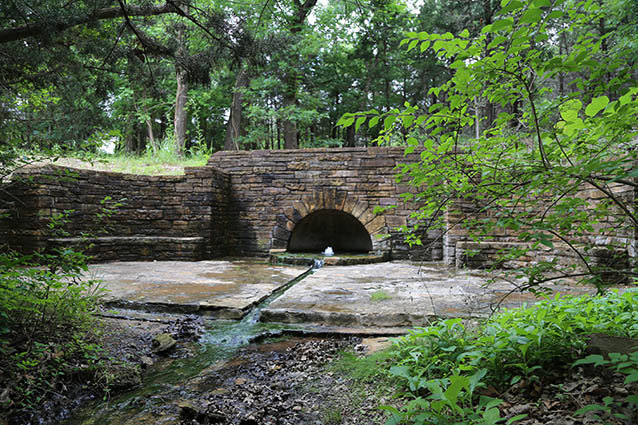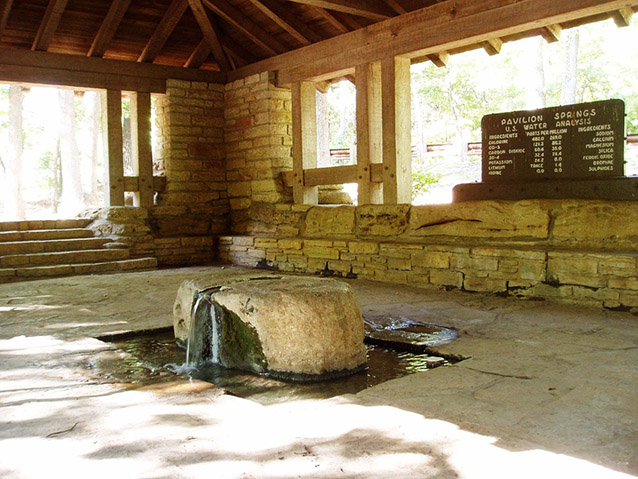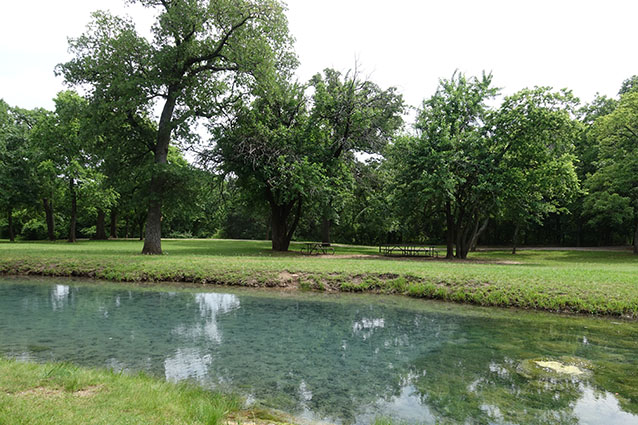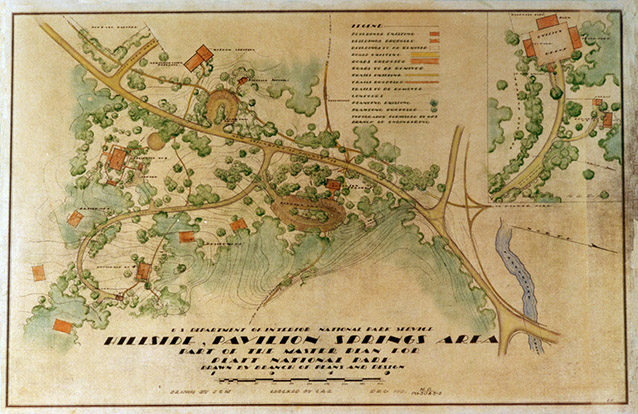The Pavilion Springs, Hillside Springs, Headquarters, and Maintenance Area landscape is located in the central portion of the Platt National Park National Historic Landmark District in Chickasaw National Recreation Area of Oklahoma. Highway 177 divides the 48-acre area, with the Pavilion Springs and Residence #2 to the east side of the road and Hillside Springs, Headquarters, and the Maintenance Area to the west.
The buildings of the Maintenance Area and the two spring complexes are excellent examples of the CCC-era landscape design projects in the park. Additionally, the Administration building reflects earlier park usage and early settlement of the area.

NPS
The separate areas of this landscape, though located in close proximity, each have their own unique features and functions. Pavilion Springs and Hillside Springs are pedestrian environments focused on the use and enjoyment of the park’s mineral waters. Knowledge of the medicinal powers of these springs existed long before the settlement of the town, during Native American habitation of the area.
Headquarters, formerly known as the Leeper House, is the administrative heart of the park. The building was one of the first to be built in Sulphur Springs, and it has great historic significance beyond its almost 100 years as a park administrative building. The building is now used as a ranger station. A residential structure located near Pavilion Springs also provides housing for park staff.

NPS / K. Ruhnke
The Maintenance Area was designed by the NPS and constructed by CCC crews. It was historically the locus of park maintenance and construction work, and it continues to serve this purpose. This quadrangle of maintenance buildings is located to the west of the Headquarters building and is well hidden from view by its tucked-away location and vegetative buffers, which were planted by CCC crews.
The Pavilion Springs, Hillside Springs, Headquarters, and Maintenance Area landscape is significant for its association with the former Platt National Park (a National Historic Landmark District), which is now part of Chickasaw National Recreation Area. The district is important for its association with the development of national park landscapes completed during the Great Depression and funded as part of Franklin Delano Roosevelt’s “New Deal” programs.

NPS
The district embodies the characteristics of the type, period, and methods of construction typical of the “Rustic style” of park design developed by the National Park Service in the years between World War I and World War II (1916-1942) under the leadership of Thomas Vint. In general terms, Rustic park design limited development to preserve natural scenery, and buildings and structures were designed in harmony with the natural landscape. This meant using hand craftsmanship, local architectural styles and natural materials such as stone, wood, and native plants in the design of each park structure or element.
As part of the larger district, the Pavilion Springs, Hillside Springs, Headquarters, and Maintenance Area landscape exemplifies all of these aspects of National Park Service development, planning and design. Although the area contains features dating to before 1930, the large majority of this landscape was constructed in the 1930s by CCC crews. In its site planning, architectural style, landscape architectural design, and small scale features, the Pavilion Springs, Hillside Springs, Headquarters, and Maintenance Area landscape area explicitly reflects the NPS principles of Rustic design and construction.

NPS / CHIC archives
The buildings of the Maintenance Area and the two spring complexes are both excellent examples of the CCC-era landscape design projects undertaken in Platt National Park. In addition, the Administration building reflects earlier park usage and early settlement of the area. Because of these elements, the extant landscape features are representative of the finest CCC work in existence, in terms of Rustic design, the number and variety of structures, and construction techniques and materials.
Quick Facts
- Cultural Landscape Type: Designed
- National Register Significance Level: National
- National Register Significance Criteria: A, C
- National Historic Landmark
- Period of Significance: 1933-1940
Landscape Links
Part of a series of articles titled Cultural Landscapes of Chickasaw National Recreation Area.
Last updated: December 30, 2019
